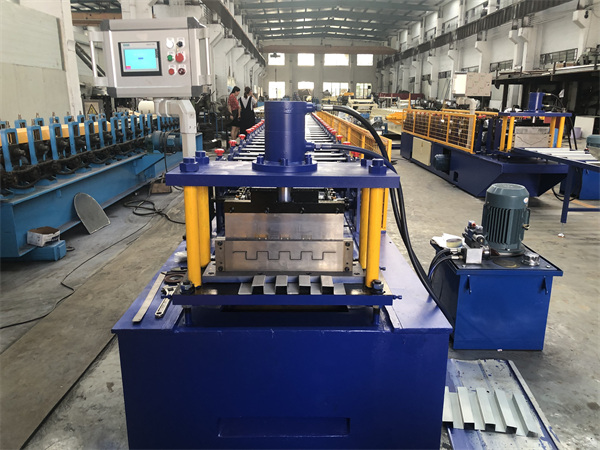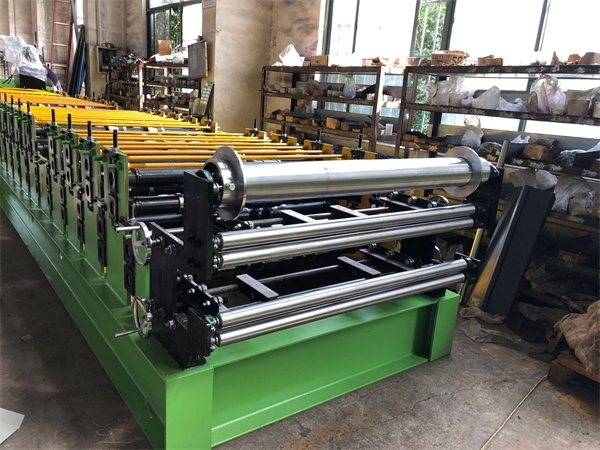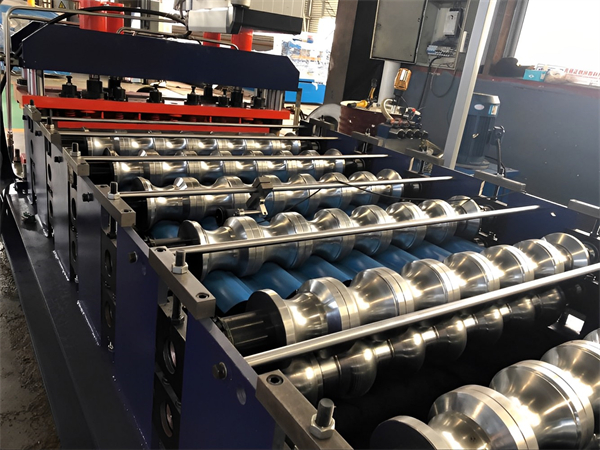Автоматические валковые машины используются для непрерывной гибки и формирования металлических рулонов в индивидуальные профили и формы поперечного сечения. Этот эффективный автоматизированный процесс идеально подходит для крупносерийного производства таких металлических деталей, как кровельные панели, дверные коробки, стеллажные системы, дорожные ограждения, каркасы солнечных батарей и т. д.
Детали, изготовленные методом роликовой формовки, отличаются высокой точностью и стабильностью размеров по сравнению с другими методами гибки. Гибкость роликовой формовки позволяет производить сложные профили быстрее и дешевле, чем изготовление или экструзия. Это делает его популярным для различных применений в инфраструктуре, строительстве, автомобилестроении, сельском хозяйстве, упаковке и других отраслях.
В этом руководстве вы найдете все, что вам нужно знать о технологии автоматической валковой формовки: принципы работы, классификация, основные компоненты, конструктивные особенности, технические характеристики, области применения, преимущества, ограничения и многое другое.
Типы автоматических машин для формовки рулонов
Существует две основные категории автоматических валковых машин:
Машины непрерывной роликовой формовки
Они непрерывно производят длинные профили из рулонов листового металла. Процессы размотки, подачи, гибки и резки интегрированы в линию, что обеспечивает непревзойденную эффективность.
Машины для формовки рулонов
Они работают в прерывистом режиме, формируя из металлических полос по одной отдельной секции за раз. На каждом этапе материал последовательно изгибается, придавая ему нужную форму.
Непрерывная рулонная формовка значительно быстрее - более 100 футов в минуту. Ступенчатые машины имеют максимальную скорость около 16 футов в минуту, но обеспечивают большую гибкость при изготовлении коротких партий продукции.
| Тип машины для формовки рулонов | Характеристики |
|---|---|
| Непрерывный | Высокая скорость до 130 футов/мин |
| Встроенная поточная формовка | |
| Большие объемы производства | |
| Шаг | Медленная скорость 10-16 футов/мин |
| Последовательная гибка на шаг | |
| Короткие или прерывистые пробежки |
Классификация по форме конструкции
Автоматические валковые машины можно разделить на группы в зависимости от типа производимого профиля:
- Рулонная формовка листов и панелей - Для плоских плоских деталей, таких как кровельные листы, гаражные ворота, боковые стенки прицепов.
- Формирование рулонного настила - Настил из гофрированного металла для полов, мостов, мезонинов
- Формовка каналов C и U - Полые профили прямоугольного сечения и прямоугольные профили для дорожных ограждений
- Формовка угловых валов - L-образные угловые секции для полок, стеллажей, рам
- Формовка швеллеров - Шляпообразные балки для стен, металлические стойки
- Облицовка рулонами - Архитектурная облицовка фасадов, стеновые панели
- Формование дверной коробки - Полые дверные и оконные рамы
- Формовка стальной балки - двутавровая балка, двутавровая балка
- Квадратная/прямоугольная труба - Полые конструкционные секции в качестве колонн, столбов для ограждений
- Специальные формы - Нестандартные профили для нишевых применений
Классификация по отраслям
Автоматические системы формирования валков предназначены для различных отраслей промышленности:
- Строительство: Стеновые панели, кровля, каркасы, окна
- Инфраструктура: Дорожные рельсы, столбы освещения, дренаж
- Автомобильная промышленность: Детали шасси, панели, бамперы
- сельское хозяйство: Силосы, теплицы, загоны для скота
- Транспорт: Кузова грузовых автомобилей, прицепы, железнодорожные вагоны
- Упаковка: Стеллажи, полки, поддоны, конвейеры
- Мебель: Хранение, дисплеи, рамки
- HVAC: Воздуховоды
- Приборы: Стиральные машины, холодильники
Такая широкая область применения делает валковую штамповку универсальным процессом металлообработки.

Основные компоненты автоматических машин для формовки рулонов
Типичная автоматизированная линия по производству валков состоит из нескольких модульных компонентов:
Разматыватель
Разматыватель содержит большой рулон тонкого рулонного листового металла, закрепленный на валу. Он плавно разматывает полосу на входном конце.
Фидер
Устройство подачи состоит из приводимых в движение прижимных роликов, которые захватывают полосу и протягивают ее через линию с постоянной скоростью.
Устройство предварительной перфорации
Дополнительные пневматические пробивные головки для пробивки отверстий или вырезов в полосе перед формовкой.
Сервоэлектрические ролики
Станции прокатки с верхними и нижними роликами постепенно изгибают полосу по мере ее прохождения. Серводвигатели точно управляют движением роликов.
Гидравлическая система
Гидравлика поднимает/опускает ролики для быстрого перехода с одного профиля на другой без использования инструментов.
Контроллер
Система управления PLC координирует все движения машины и отслеживает положение полосы.
Разматыватель/разматыватель
Сматывает готовый профиль в рулон или нарезает на отрезки необходимой длины.
Защитный кожух
Ограждение по всему периметру для безопасности оператора.
Другие варианты
Сварка, высечка, тиснение, обжим, ножницы, оснастка и многое другое между стендами.
Принцип работы валковых формовочных машин
Принцип работы заключается в непрерывном сгибании металлической полосы через ряд пар роликов, называемых формовочными станциями, для постепенного придания профилю нужной формы:
- Рулонная лента листового металла поступает из разматывателя в устройство подачи
- Приводные ролики захватывают и перемещают полосу вперед с постоянной скоростью
- Полоса проходит через прогрессивные станции, которые постепенно изгибают часть
- Верхние и нижние ролики вращаются для придания точного угла изгиба
- В роликах используются серводвигатели для регулировки давления и положения
- Система управления синхронизирует работу валков на линии
- Гидравлика регулируется вверх/вниз для быстрой смены оснастки
- Дополнительные операции, такие как штамповка, выполняются в промежутках между стендами.
- Сформированный профиль выводится на измельчитель или собирается на разматывателе
Постепенные изгибы соединяются для формирования окончательной формы конструкции. Легкая взаимозаменяемость роликов позволяет получать различные геометрические формы на одном и том же станке.
Проектирование линий прокатной формовки
Чтобы создать оптимальную автоматизированную систему валковой формовки, вот несколько ключевых факторов проектирования:
Форма профиля
Желаемая геометрия профиля определяет выбор компонентов. Для более сложных форм требуется большее количество роликовых станций.
Свойства металлов
Марка, твердость и толщина материала влияют на радиус изгиба, нагрузку на ролики и скорость линии.
Объем производства
Большие объемы требуют более быстрых поточных непрерывных процессов. Для меньших объемов подходит более медленная ступенчатая рулонная формовка.
Ширина полосы
Максимальная ширина полосы зависит от области применения. Обычно это 18 - 72 дюйма.
Необходимая точность
Для прецизионных деталей требуются ролики с сервоприводом. В остальных случаях достаточно стандартной гидравлики.
Вторичные операции
Необходимые дополнительные пробивки, выемки и сварка определят расположение линий.
Стандарты безопасности
В системе должны быть предусмотрены такие элементы безопасности, как аварийные остановки, защитные устройства, безопасное напряжение.
Гибкость в будущем
Модульная конструкция позволяет легко переходить от одного профиля к другому.
Учет этих параметров обеспечивает оптимальную производительность валковой системы.
Технические характеристики рулонных формовочных машин
Линии для формовки рулонов могут быть изготовлены по индивидуальному заказу, но некоторые типичные характеристики таковы:
| Характеристика | Типовые технические характеристики |
|---|---|
| Скорость формирования | 16 - 130 футов/мин |
| Толщина металла | 0,5 - 2,5 мм |
| Ширина полосы | 18 - 72 дюйма |
| Ширина профиля | 2 - 16 дюймов |
| Роликовые станции | 10 – 50+ |
| Диаметр ролика | 100 - 300 мм |
| Тип ролика | Вертикальный, горизонтальный, ведомый, седловой |
| Метод привода | Электрический сервопривод, гидравлический |
| Основное напряжение | 380 В, 480 В 3-фазный |
| Управление | Siemens, Allen Bradley, Omron |
| Структура | С-образная рама, О-образная рама |
| Безопасность | Полностью закрытые ограждения, защитные коврики |
Эти параметры могут быть настроены в соответствии с требованиями производства. Передовое программное обеспечение для трехмерного моделирования помогает оптимизировать конструкцию.
Основные области применения прокатных профилей
Благодаря своей гибкости и эффективности автоматизированная валковая формовка позволяет изготавливать разнообразные конструкционные детали:
Кровля и сайдинг
- Гофрированные и стоячие фальцевые металлические панели для крыш и стен
- Трапециевидные кровельные листы
- Изолированные архитектурные панели
Рамки и обрамление
- Рамы из швеллеров для мезонинов, стеллажей, платформ
- Дверные косяки и рамы из полого металла
- Стальные стойки для внутренних стен, перегородок
Продукты для обеспечения безопасности дорожного движения
- Противоаварийные ограждения из W-образных балок
- Дорожные ограждения
- Стандарты осветительных столбов
- Стойки дорожных знаков
Сельскохозяйственные здания
- Стропила из двутавровых балок
- U-образные канальные секции для загонов для скота
- Силосные кольца
- Каркасы для теплиц
Автомобильные компоненты
- Усиление внутренней панели
- Бамперы, боковые рейлинги
- Рамы шасси
- Колесные диски
Воздуховоды HVAC
- Спиральные прямоугольные воздуховоды
- Круглые/овальные воздуховоды
- Вентиляционные шахты
Эти профили оптимизируют соотношение прочности и веса и быстро изготавливаются.

Преимущества прокатных профилей
Вот некоторые из преимуществ использования деталей, изготовленных методом роликовой формовки, вместо альтернативных методов:
Высокие производственные показатели
- До 10 раз быстрее, чем экструзия
- Превышение скорости изготовления
- Идеально подходит для непрерывной работы в больших объемах
Согласованность размеров
- Соблюдение точных допусков
- Одинаковая точность по всей длине
- Меньше деформированных или деформирующихся деталей
Гибкость конструкции
- Создавайте бесконечные формы поперечного сечения
- Простая настройка профилей
- Подходит для небольших партий работ на заказ
Экономия материалов
- Никаких отработанных обрезков, как при изготовлении
- Эффективное использование тонкой рулонной стали
- Более низкая стоимость по сравнению с экструдированными формами
Прочностные свойства
- Холодная штамповка упрочняет металл
- Увеличивает прочность до 25%
- Легкие, но прочные детали
Превосходная отделка
- Гладкая, однородная текстура поверхности
- Отсутствие следов сварки или механической обработки
- Неизменный внешний вид
Снижение затрат на оснастку
- Замене подлежат только ролики
- Более быстрая переналадка по сравнению с прессами
- Масштабируемая инкрементная оснастка
Минимальная вторичная обработка
- Готовые детали с линии
- Небольшое дополнительное сверление, сварка
- Экономия дополнительных шагов
Эти факторы делают роликовое профилирование наиболее предпочтительным процессом для производства прямых металлических профилей большой длины.
Ограничения технологии валковой формовки
Однако при проектировании деталей, изготовленных методом роликовой формовки, следует помнить о некоторых ограничениях:
- Длина деталей - Ограничена шириной рулонов, максимальная длина 60-100 футов
- Высота профиля - Максимальная высота ограничена 5 дюймами
- Радиус изгиба - Радиусы менее 2х толщины чреваты растрескиванием
- Возможность расширения - Максимальная ширина полосы около 72 дюймов
- Геометрическая сложность - Предпочтительны более простые профили
- Прочность - Слабее, чем аналогичные экструзии
- Внешний вид - Следы от роликов на поверхности
- Стационарная оснастка - Изготовление новых форм требует полной замены оснастки
- Размеры партии - Короткие партии менее 1000 штук неэффективны
Инженеры должны работать в этих границах при проектировании. Рулонная формовка остается идеальным вариантом для длительного производства базовых секций в пределах возможностей технологического процесса.
Как выбрать поставщика рулонных формовочных машин
Выбор правильного партнера по производству валкового оборудования имеет решающее значение для успеха в работе. Вот важные факторы, по которым следует оценивать потенциальных поставщиков:
Опыт
- Годы работы и количество выполненных проектов
- Знание последних инноваций
Производственные возможности
- Предлагайте различные размеры машин и объемы производства
- Передовые сервоэлектрические и гидравлические технологии
- Скорость формовки для удовлетворения потребностей
Гибкость
- Быстрая переналадка между профилями
- Модульные расширяемые конструкции
- Индивидуальные инженерные услуги
Надежность
- Надежные поставщики и компоненты
- Строгий контроль качества и тестирование
- Прочная конструкция для тяжелых условий эксплуатации
Автоматизация
- Современное программное обеспечение и средства управления
- Интеллектуальная диагностика и мониторинг
- Встроенные средства безопасности
Сервисная поддержка
- Местное присутствие для оперативного обслуживания
- Программы обучения операторов
- Долгосрочная доступность запасных частей
Расходы
- Конкурентоспособные цены на оборудование
- Инжиниринг стоимости для поиска наиболее эффективного решения
Партнерство с известным производителем оборудования для формовки валков, обладающим проверенным опытом и возможностями глобальной поддержки, гарантирует успех проекта.
Ценообразование на рулонных формовочных машинах
Рулонное оборудование представляет собой крупное капиталовложение. Цены варьируются в зависимости от:
Объем производства
- Непрерывные линии большего объема стоят дороже
- Цены на роликовые опалубки начального уровня начинаются от $50,000
Размер
- Стоимость увеличивается с ростом ширины и скорости.
- Типичный диапазон от $75,000 до $500,000
Сложность геометрии
- Более простые каналы C/U, более низкая стоимость по сравнению со специализированными профилями
- Увеличение числа станций оснастки также повышает стоимость
Автоматизация
- Сервоэлектрические приводы лучше гидравлических
- Расширенное программное обеспечение и средства управления увеличивают стоимость
Аксессуары
- Вторичные пробивные/отрезные устройства
- Нестандартные конвейеры, моталки и т.д.
Грузоперевозки и монтаж
- Доставка тяжелых машин из-за рубежа
- Дополнительные услуги по установке
Приобретение готовых систем "под ключ" у надежных поставщиков обеспечивает оптимальную производительность и обслуживание. Запрашивайте индивидуальные предложения в зависимости от производственных потребностей.
Выбор между роликовой формовкой и экструзией
Вальцовка и экструзия алюминия - два распространенных метода изготовления длинных прямых металлических профилей. Здесь приведено сравнение процессов прокатки и экструзии:
| Критерии | Профилирование | Экструзия |
|---|---|---|
| Капитальные затраты | $$ – $$$ | $$$$$$ |
| Текущая стоимость | $-$$ | $$$ |
| Скорость | Высокая, 100 футов/мин+ | Медленнее, максимум 50 футов/мин |
| Используемые металлы | Сталь, алюминий | Только алюминий |
| Прочность | Средне-высокий | Очень высокий |
| Длина | До 100 футов | До 50 футов максимум |
| Фигуры | Простые и сложные | Только сложные формы |
| Допуски | Отлично, ISO | Очень хорошо |
| Отделка поверхности | Гладкая, со следами от валика | Отличный |
| Переналадка | Быстрая замена роликов | Медленные изменения |
| Гибкость объема | Хорошо, от 100pcs | Бедные, более 10 000 шт. |
| Вторичные операции | Ножницы, перфорация | Требуется изготовление |
| Типовые применения | Строительство, авто, ОВК | Транспорт, морское дело, аэрокосмическая промышленность |
В целом, валковая формовка более экономична при длительном производстве стальных профилей, в то время как алюминиевая экструзия лучше подходит для небольших партий сложных форм.
Плюсы и минусы роликовой формовки по сравнению с гибкой на листогибочном прессе
Листогибочные прессы и валковая штамповка - оба вида гибки листового металла имеют свои преимущества и недостатки:
| Метод | Преимущества | Недостатки |
|---|---|---|
| Профилирование | Очень быстрый непрерывный процесс | Возможны только линейные изгибы |
| Высокая точность воспроизведения | Ограниченные формы профиля | |
| Отсутствие разметки инструмента на детали | Специальная оснастка для профилей | |
| Более низкая стоимость оснастки по сравнению со штампами | Детали должны быть вырезаны по длине | |
| Легко автоматизировать | Максимальная высота менее 6 дюймов | |
| Хорошо подходит для серийного производства | ||
| Гибка на листогибочном прессе | Универсальны - придают любую форму изгибу | Медленнее, чем при рулонной формовке |
| Без ограничений по размерам деталей | Больше разметки инструмента | |
| Небольшие партии экономичны | Меньшая повторяемость | |
| Простая смена инструмента | Сложно автоматизировать | |
| Идеально подходит для изготовления индивидуальных деталей |
Одним словом, роликовая штамповка отлично подходит для длинных серий, в то время как листогибочные прессы лучше использовать для мелкосерийных работ по индивидуальным заказам.
Советы по обслуживанию рулонных формовочных машин
Чтобы максимально увеличить производительность валковых линий и сократить время простоя, вот несколько основных методов технического обслуживания:
Ежедневно:
- Очистите все детали от металлического мусора и пыли
- Проверьте уровень гидравлической жидкости
- Смазка подшипников качения
- Осмотрите защитные ограждения и ограничители
- Проверьте электрические и гидравлические соединения
Еженедельно:
- Проверьте натяжение ремня и масло в коробке передач
- Проверьте износ поверхности роликов
- Проверка кнопок аварийного отключения
- Проверьте выравнивание полос в рулонах
Ежемесячно:
- Проверьте износ цепи/звездочек на конвейерах
- Осмотрите ролики на предмет неравномерного износа или повреждений
- Проверьте давление в пневматической системе
- Проверьте правильность работы всех датчиков
- Проверьте токи приводного двигателя на дисбаланс
Квартал:
- Тщательная проверка всех механизмов безопасности
- Проверка допусков цилиндрических поверхностей валков
- Осмотрите валы, ключи, крепежные детали на предмет износа
- Проверка программы ПЛК и резервных копий
- Проверьте выравнивание клетей для рулонов
Правильное профилактическое обслуживание сводит к минимуму незапланированные простои и повышает производительность.

Советы по безопасности при прокатке
Безопасная работа на валковом оборудовании очень важна. Вот несколько основных рекомендаций по безопасности:
- Ограничьте доступ только для обученных операторов
- Требуйте от персонала носить перчатки, устойчивые к порезам
- Обеспечьте наличие кнопок аварийной остановки
- Держите электрические щиты запертыми на предохранительные блокировки
- Никогда не обходите и не выводите из строя защитные ограждения или коврики
- Остановите оборудование перед регулировкой инструмента
- Соблюдайте процедуры блокировки/таскировки при обслуживании
- Острые края металлических полос могут представлять опасность.
- Держите части тела подальше от вращающихся роликов
- Немедленно устраняйте любые утечки масла, чтобы предотвратить скольжение
- Никогда не забирайтесь на оборудование во время работы
- Убедитесь в достаточном освещении производственных помещений
Внедрение этих методов безопасности и обучение создают безопасную рабочую среду.
Часто задаваемые вопросы о роликовой формовке
Для чего используется валковая формовка?
Рулонная штамповка используется для изготовления длинных прямых металлических конструкций, таких как кровельные панели, дверные коробки, ограждения, дорожные знаки и каркасы солнечных батарей.
Как работает профилегибочная машина?
Он работает путем непрерывного сгибания полосы листового металла через ряд роликовых станций. Каждая станция постепенно формирует форму профиля.
Какие металлы можно подвергать прокатке?
К распространенным металлам, из которых изготавливают валки, относятся низкоуглеродистая сталь, нержавеющая сталь и алюминий. Более мягкие металлы, такие как медь или латунь, также могут быть подвергнуты валковой формовке.
Какие формы можно получить с помощью валков?
Простые длинные профили, такие как C- и U-образные швеллеры, трубы, рельсы, прутки, шпильки, балки и гофрированные листы. Возможны также сложные асимметричные формы.
Какой длины может быть деталь, изготовленная методом роликовой формовки?
Стандартная длина - до 60 футов, но некоторые машиныCopy могут производить детали длиной до 100 футов в зависимости от ширины рулонной ленты.
В чем разница между валковой формовкой и листогибочными прессами?
Валковая формовка - это непрерывный процесс, в котором используется серия роликовых станций для постепенного формирования форм. Листогибочные прессы производят индивидуальные изгибы путем приложения целенаправленного давления с помощью штампа.
Чем отличается роликовая штамповка от экструзии металла?
Рулонная формовка дешевле, быстрее и использует сталь. Экструзия позволяет получать сложные профили из алюминия, но требует больших затрат на оснастку.
Какие допуски может выдержать роликовая формовка?
Детали, изготовленные методом роликовой формовки, могут надежно выдерживать допуски на размеры +/- 0,5 мм. Некоторые машины могут выдерживать +/- 0,3 мм.
